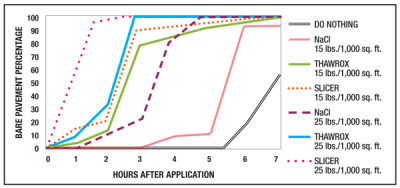August 6, 2013
Safer sidewalks and parking lots
BY S.M. KAMAL HOSSAINWinter maintenance contractors, responsible for parking lot and sidewalk safety, have few guidelines on the right snow and ice control methods, materials and amounts of material that should be applied under specific winter weather conditions. Snow and Ice Control for Parking Lots and Sidewalks (SICOPS) is a multi-year research project currently being undertaken by the iTSS Lab, led by Professor Liping Fu at the University of Waterloo, Ont., to address their needs.
To achieve this goal, the project has been designed to include a number of semi-controlled field tests in a parking lot under a combination of treatment options in terms of maintenance strategy (e.g., de-icing vs. anti-icing), material type (e.g., regular salt vs. magnesium chloride vs. organic), and material application rates. Data from these tests will help develop a quantitative understanding of the conditions that influence the effectiveness of these treatment options, and generate practical guidelines and decision support tools that can be adopted by all maintenance contractors across Ontario. The aim is to improve professionalism and environmental stewardship while reducing over salting and operational costs.

Figure 1. Sample test results: snow melting performance of difference materials and rates
The winter season of 2012-13 was more severe in Waterloo, and the weather conditions more varied than usual, including a total of 50 snow events with pavement surface temperature ranging from -12o C to 3o C and total snowfall from 0.2cm to 21cm. A large number of tests were conducted using five different solid materials (coarse and fine salt, Silver, Ice Melter, Thawrox, Jet Blue) and three liquid products (brine, CaliberM20, Snow Melter), applied for both de-icing and anti-icing purposes. In order to closely simulate the way parking lot maintenance is done in the real world, 75 per cent of the tests were conducted between 3 a.m. and 6 a.m.
The field tests conducted over a wide range of weather conditions have provided us with a large amount of data. The data allow us to derive statistically reliable conclusions about the snow melting performance of different materials under different application rates. For example, the test results have clearly shown the relative advantage of the anti-icing strategy compared with traditional de-icing methods. Figure 1 shows another example of the relative performance of two alternative de-icing materials compared with regular salt. These test results will enable us to develop models for predicting performance of different snow and ice control methods, materials and application rates, and recommend optimal salting rates for any given weather conditions, as shown in Figure 2.

Figure 2. Recommended application rates according to specific weather and site conditions
The project will continue for another year. The University of Waterloo research team is currently working hard to process all data collected over the past winter season. The team will then summarize the results and incorporate them into practical guidelines for the selection of best snow and ice control strategies, materials and application rates for parking lots and sidewalks.
Kamal Hossain is a PhD student and research assistant on the SICOPS project at the University of Waterloo. The project is funded by NSERC’s (Natural Sciences and Engineering Research Council of Canada) Collaborative Research and Development (CRD) Grants with contributions from a group of industrial partners including Landscape Ontario, Ministry of Transportation Ontario (MTO), GO Transit, Toronto Region Conservation Association (TRCA), Association of Ontario Road Supervisors (AORS), Region of Waterloo, Snow and Ice Management Association (SIMA) USA, and a number of private maintenance contractors.